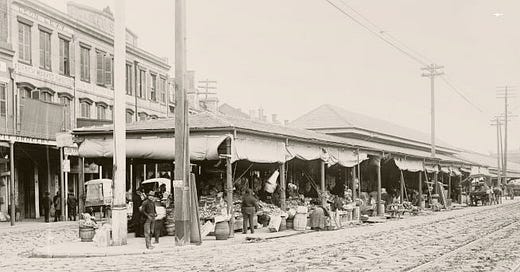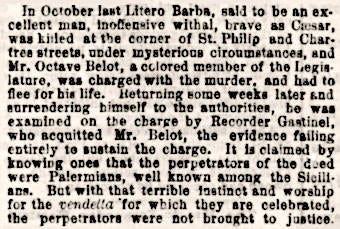Bloody ends of early NOLA bosses - Part 2
Crescent City underworld leaders lost their lives in long Mafia feud
From Part 1: A New Orleans Mafia organization comprised of Palermo immigrants formed around Raffaele Agnello near the end of the U.S. Civil War. Within the Crescent City's underworld, the Agnello Mafia was opposed by immigrant outlaw groups from Messina and Trapani. A leader of this opposition, Letterio Barba, was murdered early on October 27, 1868, after participating in a march of the Innocenti political organization.
Attempt at truce
Rumors began to circulate that Palermo mafiosi in New Orleans, directed by leader Raffaele Agnello, had been responsible for the October 27, 1868, murder of Letterio Barba.
Efforts were made to prevent additional hostility between the city's Sicilian factions - Agnello's Palermo organization and a Messina-Trapani combination previously led by Barba. Reports indicated that a truce was arranged by Ignacio Frenna and Gaetano Musico, Palermo natives who were members of the New Orleans Innocenti political organization.1
(Ignacio Frenna was born in Palermo in the 1820s, arrived in the United States in 1847 and worked as a grocer in New Orleans. Like Raffaele Agnello, he served with the European Brigade during the U.S. Civil War. He was naturalized in U.S. District Court at New Orleans on Jan. 30, 1867. At the time he arranged this Sicilian underworld truce, he was proprietor of a grocery at the corner of St. Peter and Liberty streets. He moved away from New Orleans following the Mafia war, and by 1880 was living on Sixth Street in San Francisco. He had a produce store in that city. He died in October 1890. Gaetano Musico entered the U.S. in 1855. He was naturalized in mid-April 1868. Frenna and Frank Romeo - who appears to have been naturalized just one week earlier - were witnesses to Musico’s naturalization.2)
Perhaps in celebration of the truce, Giuseppe Agnello, brother of Raffaele, organized a party in mid-December 1868. The party was held at an Agnello home on Royal Street, between St. Philip and Ursulines streets.3 The majority of attendees were Agnello's loyal Palermitani, but several of the guests were representatives of the Messina/Trapani faction.
At a late hour, there was an angry confrontation. Handguns were fired, and two wounded men were quickly carried away as the party attendees scattered. Joseph Banano, who succeeded Letterio Barba as leader of the anti-Agnello faction, suffered two bullet wounds to the body. A close Agnello aide named Alphonse Mateo (sometimes called “Minafo”4), was shot in the face. The slug passed through his face at a downward angle, entering near his nose and exiting from the area of his neck, indicating that Mateo was crouched at the time the shot was fired.
According to a newspaper account, the gunfire erupted just as Mateo was accused of murdering Letterio Barba on orders from Raffaele Agnello. Agnello reportedly fired the shots that wounded Banano.
Alphonse Mateo hid in the home Ignacio Frenna, as he recovered from his wounds. It was rumored that he and Raffaele Agnello decided during his recovery that all the Messinesi and Trapanesi in the New Orleans underworld - far fewer in number than Agnello's Palermitani - must be eliminated.
Keep reading with a 7-day free trial
Subscribe to MobHistory to keep reading this post and get 7 days of free access to the full post archives.






